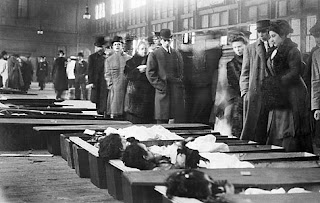
Today marks the 100th anniversary of the fire that ravaged the Triangle Shirtwaist Factory. It was the deadliest industrial disaster in New York City's history and ranks fourth in loss of life in industrial accidents in the U.S.
The Asch building, whose eighth, ninth, and top floor housed the Triangle Shirtwaist Factory, lay in the Greenwich Village area of New York City. In case you're curious, shirtwaists are basically just blouses. The factory specialized in making them and mostly employed young immigrant women. Most who worked there were either Jewish or Italian. The factory typically worked five hundred women total who worked an average of nine hours on a weekday, and seven on Saturday.
Smoking was banned in the factory, and for good reason. They were working in a textile mill and a single spark could ignite clothing. That didn't stop some of the workers though, who sneaked cigarettes in and tried to smoke without getting caught. On March 25th, 1911, the worst thing that could of happened, happened. Someone had thrown the but of their cigarette into a trash bin which had scraps in it and eventually the whole thing caught fire. The fire quickly spread in the environment and people on the eighth floor started to panic. There was a phone line to the tenth floor from the eighth, but none to the ninth and no audible alarm for a fire, so there was no way the eighth floor could tell the ninth what was happening. That's just bad planning. Unfortunately for the people on the ninth, who found out about the fire when it was clearly visible, the fire had enveloped the stairs going downward that they could use to get out and the other staircase was locked to keep people from stealing. The foreman who had the key had already escaped. Some of the women either went up the stairs to the roof or crammed into the two freight elevators while they were still working. After three minutes, the stairs became unusable.
 Many of the women from the ninth tried to escape the fire by getting out onto the fire escape which was a flimsy iron structure that may of been broken before the fire. It soon twisted and collapsed from the heat and overload and spilled victims nearly 100 ft to the concrete below. The elevator operators took many trips to get as many women from the ninth but during one of the trips some of the women had forced the elevator doors open on the ninth and jumped down the elevator shaft, making the elevator unable to be used anymore. By this time a crowd had gathered outside the building. The first person to jump was a man, and another man was seen kissing a young woman at the window before they both jumped to their deaths. The crowd witnessed sixty-two more people jumping or falling to their deaths from the top floors, who piled upon the already large amount of bodies around the building. There were so many bodies that the fire department had extreme difficulty getting close to the building. The fire department didn't have a ladder that could reach over the sixth floor and were not able to put out the fire in time to save any of the people that chose to stay inside the burning building.
Many of the women from the ninth tried to escape the fire by getting out onto the fire escape which was a flimsy iron structure that may of been broken before the fire. It soon twisted and collapsed from the heat and overload and spilled victims nearly 100 ft to the concrete below. The elevator operators took many trips to get as many women from the ninth but during one of the trips some of the women had forced the elevator doors open on the ninth and jumped down the elevator shaft, making the elevator unable to be used anymore. By this time a crowd had gathered outside the building. The first person to jump was a man, and another man was seen kissing a young woman at the window before they both jumped to their deaths. The crowd witnessed sixty-two more people jumping or falling to their deaths from the top floors, who piled upon the already large amount of bodies around the building. There were so many bodies that the fire department had extreme difficulty getting close to the building. The fire department didn't have a ladder that could reach over the sixth floor and were not able to put out the fire in time to save any of the people that chose to stay inside the burning building. In total, 146 people died from the Triangle Shirtwaist Factory Fire. 129 women and 17 men. Six of the victims remained unidentified until 2011. The owners were indicted on charges of first and second degree manslaughter for locking to doors of the stairway, thereby dooming many people. After their lawyer destroyed the credibility of one of the survivors however, they were acquitted. It was determined that the owners did not know that the doors were locked at the time. In a later suit brought against them, they ended up having to pay $75 each to each victim's family. One of the owners was later punished for locking the doors in his other factory. His fine: $20.
In total, 146 people died from the Triangle Shirtwaist Factory Fire. 129 women and 17 men. Six of the victims remained unidentified until 2011. The owners were indicted on charges of first and second degree manslaughter for locking to doors of the stairway, thereby dooming many people. After their lawyer destroyed the credibility of one of the survivors however, they were acquitted. It was determined that the owners did not know that the doors were locked at the time. In a later suit brought against them, they ended up having to pay $75 each to each victim's family. One of the owners was later punished for locking the doors in his other factory. His fine: $20.While some saw this as an opportunity to band together into unions, others saw this as a time to take a good long look at factory conditions. In 1915 an investigation was started to look at the conditions of different factories around the city. New York City's Fire Chief John Kenlon told the investigators that his department had identified more than 200 factories where conditions made a fire like that at the Triangle Factory possible. Thanks to the investigation, there was a huge push to modernize labor laws and to improve factory conditions and their fire safety. It's too bad that we have to go through a terrible tragedy to wake us up and tell us we need to change how we do things.







